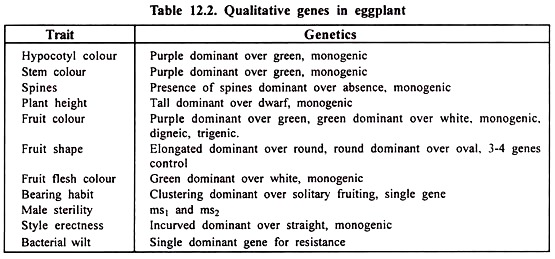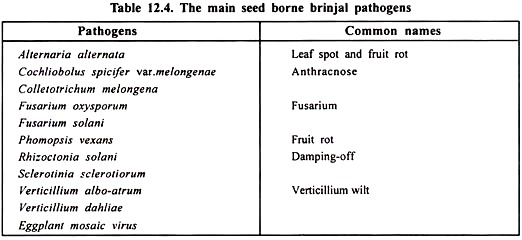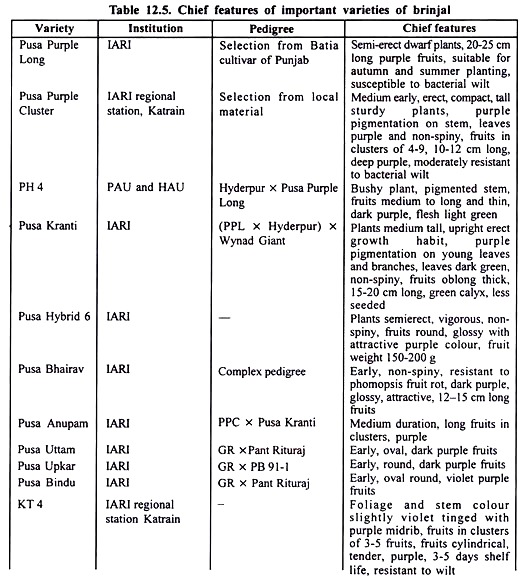After reading this article you will learn about:- 1. Origin of Brinjal 2. Botany of Brinjal 3. Distribution 4. Qualitative Genes 5. Breeding Goals 6. Development of Core Set 7. Breeding Methods 8. Seed Production 9. Varieties.
Origin of Brinjal:
Daunay (2008) has covered eggplant breeding quite extensively. According to his compilation, there are reports that S. incannum, a wild form of S. melongena is found in Southern India. S. incannum differentiated progressively, in South East Asia into a closely related species, the wild S. melongena which is still found growing in natural conditions in large areas from Southern and Eastern India to Southern China, Philippines and Indonesia and this has been described by former botanists as S. cumingii.
Under domestication process, this wild form gave rise to S. ovigerum (small round/oblong fruits with white, green or violet colour) which evolved progressively into advanced cultivars with large fruits. S. insanum, widespread in India is probably a form of S. ovigerum which reversed to the wild state with strong prickliness.
Later on all these taxa were brought under the umbrella of S. melongena. A. Decandolle has mentioned India as the place where eggplant was known since ancient times and regarded it as a native of Asia. According to N. I. Vavilov, the eggplant originated in the Indo-Burma region.
Botany of Brinjal:
Brinjal is an annual herbaceous plant. Inflorescence is often solitary but sometimes it constitutes a cluster of 2-5 flowers. Solitary or clustering nature of inflorescence is a varietal character. Flower is complete, actinomorphic and hermaphrodite. Calyx is five lobed, gamosepalous and persistent. It forms a cup-like structure at the base.
Corolla is five lobed gamopetalous with margins of lobes incurved. There are five stamens which are free and inserted at the throat of corolla. Anthers are cone-shaped, free and with apical dehiscence. Ovary is hypogynous, bicarpellary, syncarpous and with basal placentation.
Heterostyly is a common feature. Four types of flowers have been reported depending upon the length of style.
These are:
(i) Long styled with large ovary,
(ii) Medium styled with medium size ovary,
(iii) Pseudo-styled with rudimentary ovary and
(iv) True short styled with very rudimentary ovary.
Fruit setting flowers consist of long and medium styled flowers. Fruit setting in long styled flowers normally, varies from 70 to 85% and that in medium styled flowers from 12 to 55%. The non-fruit setting flowers consist of short styled flowers in which androecium is fertile but stigma is smaller with underdeveloped papillae.
Eggplant is usually self-pollinated but the extent of cross-pollination has been reported as high as 29% and hence, it is classified as often cross-pollinated or facultative cross-pollinator. Out-crossing takes place with the help of insects (bumble bees, wild bees and domestic bees).
Flowers generally emerge 40-45 days after transplanting. Anthesis occurs at about 6-8 a.m. in August-September and usually between 9.30 to 11.15 a.m. during winter (December-January). Stigma receptivity is highest during anthesis, i.e. flower opening. Anthers usually dehisce 15 to 20 minutes after the flowers have opened.
The receptivity of the stigma can be observed from its plump and shiny appearance which gradually becomes brown with the loss of receptivity. The period of effective receptivity ranges from a day prior to flower opening until about four days after opening.
Pollen usually remains viable for a day during summer and 2-3 days in winter under field conditions. For emasculation, a healthy long or medium styled, well developed bud from the central portion of the plant is selected.
The bud is opened gently with the help of fine pointed forceps one or two days before the opening of the bud and all the five anthers are carefully removed. For pollination, freshly dehiscing anthers are picked up and are slit vertically with fine needle to get sufficient pollen at the tip of the needle.
Pollen are applied on the stigma of the emasculated flower bud. It is labelled and covered with small pollination bag. Emasculation is done in afternoons followed by pollination in next morning. Emasulated buds are covered with pollination paper bags and bags are secured with U clip. The pollinated buds are covered with the same bag but now bags are stappled.
Distribution of Brinjal:
Brinjal (known as eggplant in USA and aubergine in France and UK, Solanum melongena L., 2n = 2x = 24) is one of the few cultivated Solanaceous species originating in the Old World. It is known as brinjal in India, where it was domesticated long ago and, where the greatest diversity is found. It is a major vegetable crop in several countries like India, Japan, Indonesia, China, Bulgaria, Italy, France, the USA and several African countries.
As per FAO statistics-2004 and quoted by Daunay (2008), the data on acreage, production and productivity in major eggplant growing countries is as follows (Table 12.1). As per FAO-data-2005, the global area under brinjal cultivation has been estimated to be 1.85 million ha with 32 million tons of production.
Qualitative Genes of Brinjal:
The available information based on Chadha (1993) and Kalloo (1993) is summarised in Table 12.2.
Breeding Goals of Brinjal:
1. High yield
2. Earliness
3. Fruit shape, size and colour as per consumers’ preference
4. Low proportion of seed/higher seed depending upon use
5. Soft flesh
6. Fruit colour retention in summer
7. Lower solanine content
8. Upright sturdy plant free from lodging
9. Resistance to:
i. Bacterial wilt (Pseudomonas solanacearum/Ralstonia solanacearum Smith)
ii. Phomopsis blight (Phomopsis vexans)
iii. Little leaf (Mycoplasma like bodies/Phytoplasma)
iv. Root knot nematodes
10. Tolerance to:
i. Shoot and fruit borer
ii. Jassids
iii. Epilachna beetle
Development of Core Set in Brinjal:
Gangopadhyay et al. (2010) have presented a scientific perspective on this issue. India being a primary centre of origin of eggplant, possesses large variability for growth habit, leaf blade lobing, calyx colour, fruit shape, size, and colour and colour distribution.
These authors evaluated 1798 accessions of brinjal in 2005 and 2006 for 28 morphological traits, namely, petiole colour, leaf blade lobing, leaf blade tip angle, leaf colour, catalyse colour, calyx spininess, corolla colour, fruit colour, fruit colour distribution, fruit shape, fruit curvature, fruit apex shape, fruit length-breadth ratio, seediness, plant height, plant spread, number of primary branches, petiole length, leaf blade length, leaf blade width, days to 50% flowering, peduncle length, fruit length, fruit width, fruit weight, fruits/plant, days to 50% fruit harvest and fruit yield/plant.
O.H. Frankel in 1984 has proposed that entire collection be reduced to a manageable sample or “core set” that would represent the genetic diversity of the crop and its relatives with minimum repetition. The core set shall serve as a working collection and would enable easy retrieval of germplasm and related information.
The accessions not included in the core set, are designated as reserve collection. Based on multivariate patterns of variation in the entire collection, 181 accessions were included in the core set which is a representative of the eggplant germplasm of cultivated species conserved in the base collection at NBPGR.
Breeding Methods/Selection Criteria of Brinjal:
For production breeding combined with resistance breeding, the common breeding methods applicable to brinjal are:
1. Pure-line selection
2. Pedigree method
3. Bulk method
4. Modified pedigree (single seed descent)
5. Combination of bulk and pedigree methods
6. Backcrossing
7. Heterosis breeding
Pure-line selection is applicable to landraces/heterogeneous materials collected from farmers’ field. In this method original stock seed is space planted, preferably in wilt-sick plot. Individual plants are examined at full fruiting stage and superior individual plants based on earliness, fruit shape, size, colour, yield (visual estimate) plant type, resistance to diseases/pests are selected and harvested separately.
Next year, individual plant progenies (6 m long, 5 rows) are planted and uniform progenies with desirable traits are selected and seeds of plants within a selected progeny row are bulked and a new line is thus constituted for further trials. In case some individual plant progenies show segregation, individual plant selection may be repeated.
In pedigree method individual plants are selected in the segregating generations from a cross on the basis of their desirability adjudged individually and on the basis of a pedigree record. Selection of parental cultivars is crucial for the success of this method. The parental lines selected are usually superior lines lacking in a few desirable traits only and of better general combing ability.
Some such lines in eggplant are as follows:
Pusa Purple Long, Pusa Purple Cluster, Pant Samrat, Pant Rituraj, PH 4, Pusa Kranti, KT 4, Azad Kranti, H 7, Hisar Shyamal (H 8), Jamuni Gola, Punjab Barsati, NDB 25 and bacterial wilt resistant cultivars such as BB7, BWR12, Singnath, Bholanath, Green Star, Blue Star and Hazari.
Back crossing should normally be followed to transfer genes conferring resistance to diseases, for example, bacterial wilt resistance which has been shown to be under a single dominant gene.
Single seed descent method is a selection procedure in which F2 plants and their progenies are advanced by single seed from each plant until genetic purity is virtually attained i.e. up to F6, after which, the same procedure is applied as applicable under pedigree method.
Under this method, less resources are required and 2 generations can be easily accommodated per year as even poor crop can be advanced to the next generation because a few seeds are collected from each plant without exercising any selection.
Considerable heterosis for fruit yield, quality and resistance to diseases has been reported in eggplant. F1 hybrids are becoming popular day by day where manual emasculation and pollination are very much in practical use.
A few combinations found promising and worth exploiting on commercial scale are as follows:
Historically eggplant F1 hybrids have been common in Japan and there were about 20 hybrids in cultivation in 1935s. Hybrids are on rapid expansion in Asian countries such as China, India, Thailand, Vietnam; etc., where, traditional cultivars are under erosion and replacement by the hybrids.
In India, currently, about 25 tons of hybrid seeds are being produced and sold by several private seed sector Companies like Mahyco, Nunhems, Seminis, Sungro, Bejo Sheetal, Syngenta, Krishidhan Vegetable Seeds, Vibha Seeds, etc. The trend is still on increase. Eggplant hybrids were registered in Europe in 1970s. In Europe, the percentage of hybrid eggplant in the total cultivars was 67% in 2000 which increased to 72% in 2005 for a total of 247 cultivars.
Eggplant cultivar types and diversity differ from one country to another one. European and American cultivars have 200-400 g fruit with globose, intermediate or long fruit shape, shiny black fruit colour and green, almost unarmed calyx. South European traditional cultivars (in Spain and Italy) show much diversity for fruit colour (white, white striped with purple, reddish, violet and white, purple and green).
In Sudan, the Black Beauty type is dominant (large, globose, slightly fascinated, and dark purplish fruits). In Thailand, fruits are of diverse colour, such as green ping pong shaped and sized fruits, together with small, long violet or green or white fruits In China, there is great diversity for fruit types (large fruits of round, intermediate or long shape and of violettish colour influenced by light.
Japanese cultivars have shiny, almost black colour and are quite soft. It is India, where, one finds greatest diversity for fruit shape, size and colour. In north India, purple long, purple half long and purple round cultivars are common. In Orissa, oval shape fruit with green colour and white stripes at the base are common.
In Maharashtra, people prefer small, round/oval fruits with purple colour, small oval fruits with purple + white stripes, small oval fruits with purple + white + green stripes and preferably with spines on the calyx. In south India, medium long fruits with green colour are preferred.
Small round or oval fruits with violet colour are preferred in Tamil Nadu. Besides these dominant geographical types, there are some other types as well in small pockets. This is quite natural as eggplant originated in India.
Seed Production of Brinjal:
Isolation Distance:
1. Breeder/foundation seed – 200 m
2. Certified seed – 100 m
Cultivar Description for Seed Production:
There are open-pollinated and F1 hybrid cultivars. The following outline is based on George (1999).
1. Seedling
2. Anthocyanin colouration of the hypocotyl: absent or present
3. Plant attitude: erect, semi-erect or prostrate
4. Stem: Anthocyanin colouration : absent or present
5. Leaf: Margin: entire, dentate or sinuate
6. Fruit:
Curvature (only for cylindrical types): absent, very weak, weak, medium, strong, very strong
Skin colour at commercial harvesting: white, yellow, green, mauve, purple Stripes: absent or present
7. Ribs: absent or present
8. Anthocyanin colouration below calyx: absent or present
9. Anthocyanin colouration of calyx: absent or present
Colour of flesh: whitish or greenish
10. Time of beginning of flowering: early, medium or late
11. Time of physiological ripeness: early, medium or late
Roguing:
1. Before flowering: Plant habit, pigmentation, vigour and foliage typical of the cultivar
2. Early flowering and first fruit developing: General plant habit, and characters as for stage 1, also the degree of spininess
3. First fruit at market maturity: Potential yield characters, fruit morphology, fruit colour, including stripes according to cultivar description, spininess of calyx
Production of F1 Hybrid Seed:
F1 hybrid seed is produced by hand emasculation and pollen transfer as described for tomato. In India, for 1 unit production plot (1000 m2), 5 g of female parent seed and 3 g male parent seed is needed. The seed multiplication ration is 1000. The flower buds and flowers are larger than those of tomato and the work is less tedious.
As with tomato, the male plants are sown at a date to ensure that there is an adequate supply of pollen when the female line’s anthesis commences. At the start of the pollinating programme all new or old flowers on the female line that will not be used are removed. It is also important to remove any developing fruit that has already set as a result of open pollination.
The change of petal colour from white to a blue/violet colour is usually regarded as an indication that the anthers have already dehisced. Pollen collection from the male and transfer to the female parent are done as described for tomato. The cross- pollination of each flower is indicated with a secure but slightly loose tie around the individual flower’s stalk, i.e. peduncle.
In order to ensure that seed development is complete, the fruits are usually hand picked at a ripe stage. Some seed producers leave the fruit on the plant until the abscission layer just behind the calyx is fully developed.
If hybrid seed is being produced care must be taken to exclude fruit resulting from open pollination and in this case it is better to pick a fruit resulting from hybridization, before it is likely to drop off the plant. There are two basic methods used for the extraction of brinjal seed, a wet and a dry extraction process. There is a general tendency to favour the wet extraction especially in large- scale seed production. The dry process is favoured where relatively small amounts of seeds are produced.
For the primary extraction of seeds, the fruits are crushed and the seeds are separated from the remainder of the fruit pulp and debris as described for tomato seed extraction. The seeds are extracted from the debris by the same process as in tomato, but it is sometimes necessary to spray clear water into the separation screen cylinder to obtain the maximum seed yield. The extra water tends to wash the seeds free from the pulp.
In some countries, the over-ripe brinjal fruits are dried in the sun, until they shrivel. In the purple and purple-black fruited cultivars the drying out is accompanied by a fading of the skin colour to a coppery brown. The fruits are then hand beaten and the dried seeds hand extracted. This method is time consuming and laborious.
Seed Yield and 1000-Seed Weight:
A satisfactory seed yield is approximately 150-200 kg/ha. The 1000-seed weight is approximately 5 g, but smaller-seeded cultivars have a 1000-seed weight of about 4 g.
Seed Borne Pathogens:
The main seed-borne pathogens are listed in Table 12.2
Varieties of Brinjal:
Several promising cultivars of brinjal, viz., Pusa Purple Long, Pusa Purple Cluster, Pusa Kranti, Pusa Purple Round, PH 4, Pant Samrat, Pant Rituraj, KT 4, Punjab Barsati, Azad Kranti, K 202-9, Arka Navneet (Hybrid), T 3, Jamuni Gola, Pant Brinjal Hybrid 1, Pusa Anmol (hybrid), Arka Kusumakar, H7, Hisar Shyamal (H 8), H 16, Pusa Hybrid 5, Pusa Hybrid 6, NDB 25, Sel 4, DBSR 31, KS 224, DBR 8, DBSR 44, NDBH 6, ABH 2, BB 26, PLR 1, BB 7, BWR 12, Arka Nidhi, Swarna Mani, Punjab Sadabahar, Utkal Tarini, etc., have been identified/ released.
Chief features of important varieties are summarised in Table 12.5:
A large number of eggplant hybrids by private sector seed companies are in the market to the tune of about 25 tons of seed. Since the market scenario and dynamics keep on changing very fast, the readers are advised to visit the websites of the companies, like Mahyco, Seminis, Nunhems, Syngenta, Namdhari Seeds, Krishidhan Seeds, Sungro, Advanta, JK Agri Gentics, VNR seeds, Nuziveedu Seeds, Rasi Seeds, etc. to have an update.






